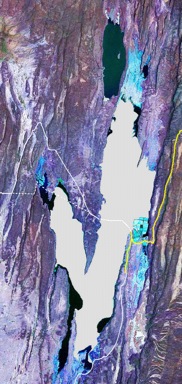

So many rocks, so little time
The best thing about geology, is that there are rocks almost everywhere you go.
Seriously though, this page is to acquaint the curious with the major geologic formations of the Magadi area. The maps, instead of showing specific points like in the previous pages, will show the extent of the formation in the area, and then a representative image of that unit. Hopefully, this will help people get to know the units quickly when you are finally in the field.
The image at the top right, for those who want to know, is a growth of salt tubes on a chunk of trachyte (I’ll provide a XRD analysis of these structures sometime in the near future). These little growths can be found along the salt ponds where the Magadi Soda Co. evaporates down the brines. They are very fragile, and my attempt to bring one home in 2006 was a failure. Packed well, taken as carry-on, and treated gently, one might survive the journey.
The formations below are listed from oldest to youngest.








The Magadi Trachytes (or Plateau Trachytes, which is a name in some older papers that also include several units of different ages) are a very extensive volcanic unit that covers most of the center of the rift up to Suswa volcano and down to Gelai volcano (in Tanzania). They were probably erupted from fissures, and have since been heavily faulted, which makes off-roading very difficult. Most of the hills and cliffs in this area are composed of these trachytes, while the grabens between them are filled with various sediments.


Age

1.4 - 0.7 Ma









The Oloronga Beds are the deposits of an ancient lake which is believed to have connected the Magadi and Natron lake basins, but, since the Oloronga Beds seem to predate most of the grid faulting (since they are affected by it) then the Magadi basin would not have been well-defined at this point in time. In any event, these beds show evidence of human habitation of this area, with worked stone and ostrich egg beads being associated with these deposits. To the NE of Magadi, there is a trachyte flow that seems to have entered the ancient lake, which gives an age of 0.7 Ma. This is the youngest age for the Magadi Trachytes, and gives a boundary for when the lake had to have existed by.


Age

0.8 - 0.3 Ma









AKA: the Chert Series in Baker’s 1958 report. This formation was given its current name by Behr and Rohricht (2000), and consists of thick chert beds. The most recent theory is that they are biologic in origin, and have risen diapirically through the overlying sediments to form chert mounds. Interestingly, these cherts seem to respond in the thermal wavelengths as recorded in the ASTER images, which I believe may be due to their dark outer varnish.
Also, this unit seems to exhibit a variety of textures, with the image above being common of the southern areas. There are good exposures in the escarpment west of the salt ponds, and south of the guard shack.


Age

98 ka









These beds are also old lake beds, and represent the most recent series of high lake levels. Lake level fluctuated during this time, and there were several periods where the Magadi and Natron basins were connected. These beds often have a white crust on them, and are well exposed in the area south of the guard shack. During the time of the High Magadi Beds, the lake was much fresher, and large tilapia fossils can be seen in certain layers of this unit (don’t ask me where, I’ve yet to find them). The tilapia managed to survive and live in the recent lake, but with conditions so harsh, they don’t get much bigger than 2 inches.


Age

20 - 9 ka









This is the unit that is currently being deposited, and is the reason there is a Magadi Soda Company and town on this little lake. The trona is up to 40m thick, and seems to be an unlimited resource. The Soda Co. will harvest one area for a number of years, then switch to other area, and the first location will fill in with trona again.
During certain times of the year, the trona surface will develop a pink color, and this is due to the halophilic bacteria that thrive in those conditions. These are the same critters that turn the brine pools that deep red color.


Age

9 ka- present














